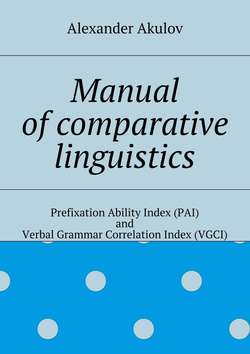Читать книгу Manual of comparative linguistics - Alexander Akulov - Страница 7
2. Prefixation Ability Index (PAI) allows us to see whether two languages can potentially be genetically related
2.1.5. PAI of a group/stock
ОглавлениеPAI of a group or a stock can be calculated as arithmetical mean and it’s quite precise for rough estimation.
One can probably say that just arithmetic mean is quite rough estimation and in order to estimate PAI in a more precise way it would be better to take values of PAI of particular languages with coefficients that show proximity of particular languages to the ancestor language of the stock. Coefficient of proximity is degree of correlation of grammar systems.
Let’s test this hypothesis and see whether it so.
For instance, in the case of Austronesian it would be somehow like the following:
Malagasy^PAN9 ≈ 0.5;
Bunun^PAN ≈ 0.8;
Philippine group^PAN ≈ 0.7;
Indonesian^PAN ≈ 0.6;
Cham^PAN ≈ 0.4;
Polynesian languages^PAN ≈ 0.5.
Indexes show degree of proximity of languages (grammatical systems). In current case these indexes are not results of any calculations but just approximate speculative estimation of degrees of proximity of modern Austronesian languages with Proto-Austronesian; it is supposed that Formosan languages and so called languages of Philippines type are the closest relatives of PAN among modern Austronesian.
If we take each particular PAI value with corresponding coefficient of proximity we get that PAI of Austronesian is about 0.44.
If we take just arithmetical mean without proximity coefficients we get 0.6.
0.6 is obviously closer to real values of PAI of Austronesian languages than 0.44. Hence thereby it’s possible to state that just arithmetical mean is completely sufficient way to calculate PAI of a group/stock while PAI calculated with use of proximity coefficients gives results that differ seriously from reality.
9
PAN means Proto-Austronesian; “^” is sign of grammar/structure correlation
